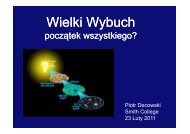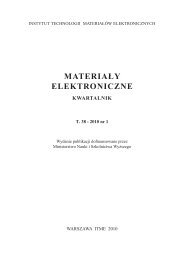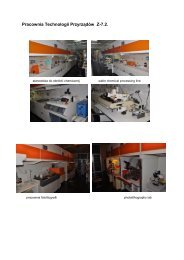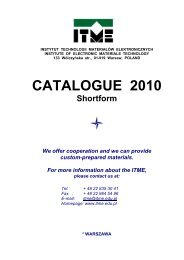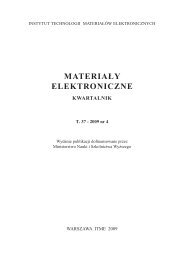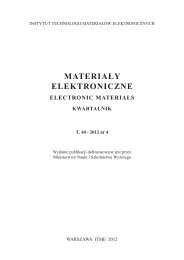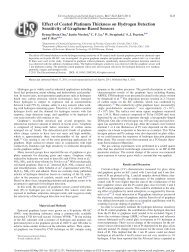MATERIAÅY ELEKTRONICZNE - ITME
MATERIAÅY ELEKTRONICZNE - ITME
MATERIAÅY ELEKTRONICZNE - ITME
Create successful ePaper yourself
Turn your PDF publications into a flip-book with our unique Google optimized e-Paper software.
P. Kamiński, M. Kozubal, J.D. Caldwell, ...<br />
Fig. 2. Images of the minority carrier lifetime distributions<br />
for the as-grown epilayers A (left) and B (right) with the<br />
nitrogen concentrations 1.1 × 10 15 cm -3 and 4.0 × 10 15 cm -3 ,<br />
respectively.<br />
Rys. 2. Obrazy ilustrujące rozkład wartości czasu życia<br />
mniejszościowych nośników ładunku bezpośrednio po<br />
procesie wzrostu w warstwie epitaksjalnej z grupy A (strona<br />
lewa) oraz w warstwie epitaksjalnej z grupy B (strona<br />
prawa) o koncentracji azotu odpowiednio 1.1 x 10 15 cm -3<br />
i 4.0 x 10 15 cm -3 .<br />
of the epilayer B area is ~ 520 ns. In view of the<br />
previous results [1, 16], the Z 1/2<br />
center is recognized<br />
to be the main lifetime killer in the epitaxial 4H-SiC.<br />
So, the minority carrier lifetime can be written as<br />
1<br />
p <br />
[ Z ] v <br />
(2)<br />
1/ 2<br />
where [Z 1/2<br />
] denotes the Z 1/2<br />
center concentration, σ p<br />
is the capture cross-section of the Z 1/2<br />
center for holes<br />
and is the mean thermal velocity of holes. Equation<br />
(1) indicates that the lifetime is inversely proportional<br />
to the Z 1/2<br />
center concentration. Therefore,<br />
p<br />
p<br />
the ratio of the lifetime values for the epilayers A and<br />
B should be equal to the ratio of the values of the Z 1/2<br />
center concentrations in the epilayers B and A. Taking<br />
into account the above mentioned data, the former is<br />
equal to 1.87 and the latter is equal to 1.89. Thus, our<br />
results are consistent with the earlier experimental<br />
data showing that the minority carrier lifetime<br />
in epitaxial 4H-SiC is predominantly affected by<br />
the Z 1/2<br />
center concentration [1, 11 - 12,16]. However,<br />
according to the results demonstrated by<br />
Danno et al. [11] and Kimoto et al. [12], the measured<br />
value of the lifetime can be significantly affected<br />
by surface recombination and recombination in<br />
the substrate when the trap concentration is lower<br />
than 1 x 10 13 cm -3 . In our studies these effects have<br />
not occurred and we managed to observe the decrease<br />
in the minority carrier lifetime due to increasing<br />
the Z 1/2<br />
center concentration from 1.8 x 10 12<br />
to 3.4 x 10 12 cm -3 . It is worth adding that that the<br />
μ-PCD measurements mentioned in Refs. 11 and 12<br />
were carried out at the microwave signal frequency of<br />
26 GHz, whereas our measurements were performed<br />
at ~ 10 GHz. The capture cross-section of the Z 1/2<br />
center for holes at 300 K, calculated from Eq. (1), is<br />
~ 6x10 -14 cm -2 . It should be noted that Z 1/2<br />
defect is an<br />
amphoteric, negative-U center having the donor level<br />
(0/+) located closer to the bottom of the conduction<br />
band than the acceptor level (-/0) [8, 14]. The large<br />
value of σ p<br />
indicates that the hole capture by the Z 1/2<br />
center is enhanced by attractive Coulombic potential.<br />
Thus, the acceptor level of the center seems to be the<br />
dominant recombination level.<br />
The DLTS spectra (Fig. 1) show that the Z 1/2<br />
center concentration increases almost two times with<br />
increasing the nitrogen concentration from 1.1 × 10 15<br />
to 4×10 15 cm -3 . This experimental fact is consistent<br />
with the results reported by Pintilie et al. [8] revealing<br />
that the concentration of Z 1/2<br />
center is not only<br />
positively correlated with the N donor concentration,<br />
but is also enhanced with the higher C/Si ratio. In<br />
view of these results, Eberlein et al. [14] proposed<br />
a model for the microscopic structure of the Z 1/2<br />
center,<br />
based on first-principles calculations performed<br />
using spin-polarized density functional theory (DFT).<br />
According to this model, the Z 1/2<br />
center is presumably<br />
a complex defect composed of a dicarbon interstitial<br />
and an interstitial-nitrogen atom. However, the direct<br />
nitrogen involvement in the Z 1/2<br />
center formation was<br />
contradicted by subsequent studies from Storasta et<br />
al. [13, 17] that indicated that the concentration of<br />
the Z 1/2<br />
center in electron irradiated 4H-SiC epilayers<br />
can exceed the nitrogen concentration by one order<br />
of magnitude. Thus, the microscopic structure of this<br />
center is still not fully understood, although there are<br />
29




